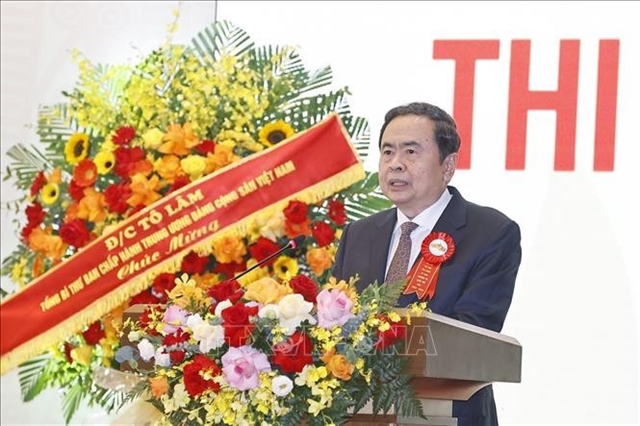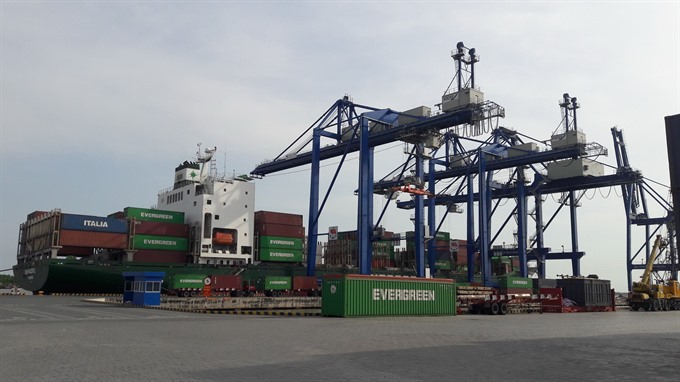 Society
Society

The Ministry of Transport has announced plans to limit the cargo handled at HCM City’s Cát Lái Port since volumes are exceeding its handling capacity, exerting pressure on the city’s transport infrastructure.
 |
| Tân Cảng – Phú Hữu Port in HCM City’s District 9. VNS File Photo. |
HCM CITY -- The Ministry of Transport has announced plans to limit the cargo handled at HCM City’s Cát Lái Port since volumes are exceeding its handling capacity, exerting pressure on the city’s transport infrastructure.
According to the Maritime Department, the cargo handled at Cát Lái Port has been increasing relentlessly, going up from 47 million tonnes in 2016 to 56 million tonnes last year, causing traffic flows into the port also to rise.
Statistics from the HCM City Department of Transport show that this year 19,775 vehicles entered the port every day on average, an increase of 14 per cent from last year.
But despite the port overload and traffic congestion, enterprises from Đồng Nai and Long An provinces prefer to route their cargo through Cát Lái instead of other ports such as Hiệp Phước (in HCM City’s Nhà Bè District) and Cái Mép – Thị Vải (in Bà Rịa – Vũng Tàu).
The Maritime Department explained that at VNĐ5 million per container the cost at Cái Mép – Thị Vải is double that of Cát Lái.
Besides, agencies such as animal, plant and food quarantine and product quality examination have yet to open offices at Cái Mép – Thị Vải Port.
At Cái Mép – Thị Vải Port, there are few empty containers meaning importers need to transport them from HCM City, Bình Dương or Long An adding 50 per cent to the transport cost.
Owners of shipping lines also choose Cát Lái because it has other advantages such as good location in terms of being closer to the source of cargo and government offices and good services at competitive prices.
Some four vessels leave Cái Mép – Thị Vải every week while 60-70 leave Cát Lái, offering more options to clients.
Due to various reasons, transportation costs are lower at Cát Lái than Cái Mép – Thị Vải Port, the Maritime Department said.
Infrastructure pressure
HCM City authorities consider the road leading to Cát Lái Port a traffic hot spot.
The Maritime Department has proposed banning transport of large volumes of cargo to and from the port by land and has instead proposed the use of inland waterways for the purpose.
Cargo from Đồng Nai and Long An provinces and Hiệp Phước (in HCM City’s District 9) should be transported to and from ports and inland container depots by inland waterways, it said.
Cargo to and from the Mekong Delta would also be transported from Cát Lái by inland waterways, it said.
The department wants the Ministry of Agriculture and Rural Development to permanently station animal and plantation quarantine inspectors at the Cái Mép – Thị Vải Port.
The finance ministry has instructed the Việt Nam Customs Bureau to install security screening equipment at Cát Lái Port.
It has instructed the Việt Nam Customs Bureau and the HCM City and Bà Rịa- Vũng Tàu customs departments to create favourable conditions for enterprises to unload their cargo at Cái Mép – Thị Vải, Hiệp Phước and other ports in the region.
The Ministries of Transportation and Finance will cut tolls charged on National Highway No 51 for trucks and other vehicles transporting cargo between Cái Mép – Thị Vải Port and factories and industrial parks in Đồng Nai and Bình Dương provinces.
The Government has instructed the ministries to offer incentives to vessels of under 50,000DWT to attract them to Cái Mép – Thị Vải Port.
Nguyễn Phương Nam, manager of Cát Lái, said to ease the traffic on roads leading to the port, it had collaborated with the city transportation department and other relevant agencies to set up a team to effect measures to unclog them.
The team has also joined hands with the Customs Bureau to facilitate transport of cargo from Đồng Nai and Bà Rịa – Vũng Tàu provinces to Cái Mép – Thị Vải Port.
Port authorities in Cái Mép – Thị Vải are also offering incentives such as reducing and waiving cargo handling fees and assisting with customs formalities to attract customers--VNS.




